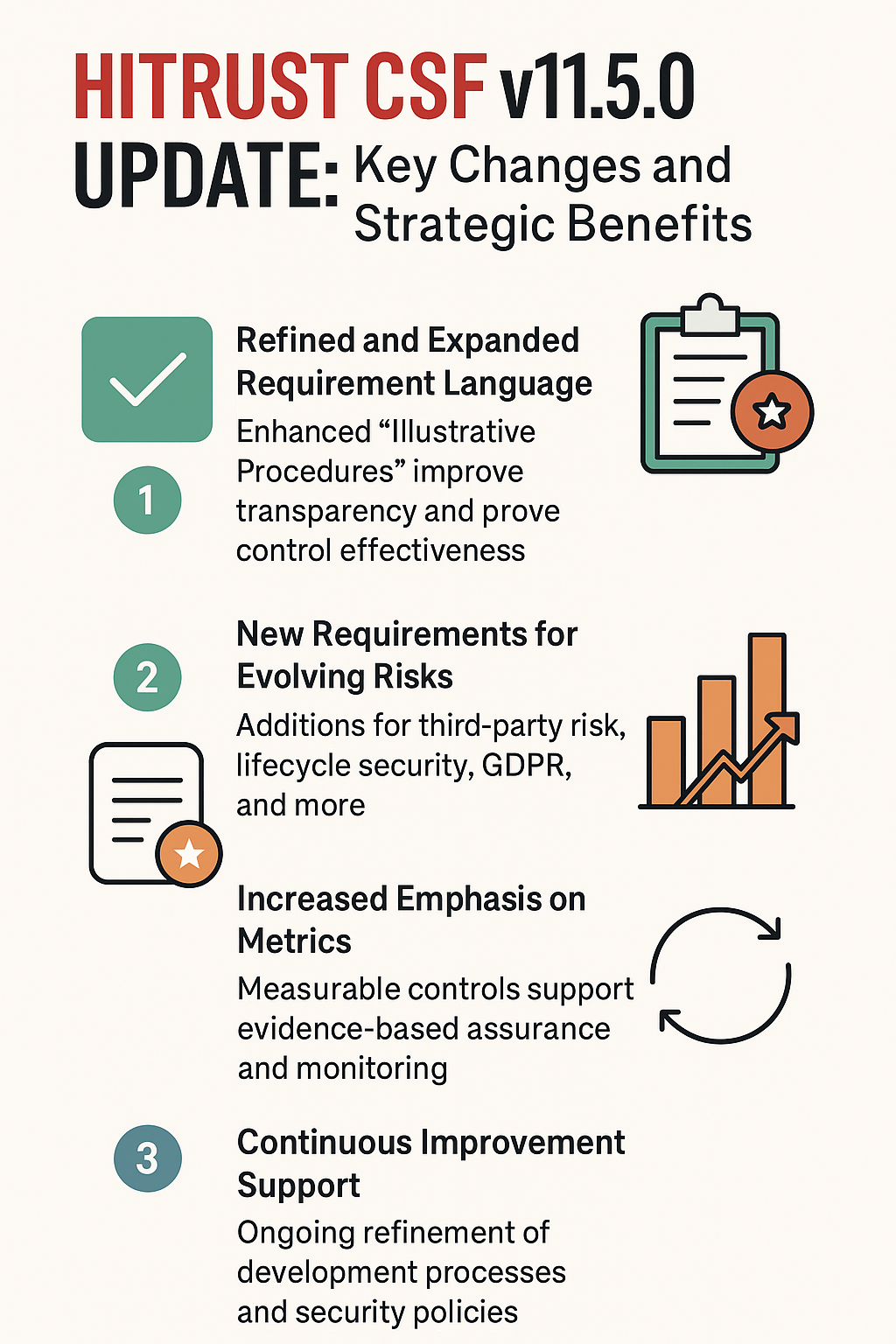Navigating the HITRUST e1 Certification: Turning Challenges into Opportunities
In today's data-sensitive world, especially within healthcare and an increasing number of other regulated industries, robust cybersecurity isn't just...

April 2025 — HITRUST has released version 11.5.0 of its Cybersecurity Framework (CSF), marking a significant evolution from the previous 11.4.0 release.
The update introduces enhanced clarity, expanded regulatory mappings, and increased auditability, all critical to organizations striving for strong security posture and continuous compliance.
In this blog, we’ll break down what’s new, what’s changed, and why it matters for your risk and compliance strategy.
Many existing Question Requirement Records (QRRs) have been updated with more detailed "Illustrative Procedures" — clear guidance on how to measure and validate implementation. These updates:
Improve transparency for internal audits
Provide better direction for assessors
Help organizations prove control effectiveness
Example: Enhanced supply chain requirements now explicitly call for documented, annually reviewed risk management plans covering everything from R&D to disposal.
HITRUST v11.5.0 introduces numerous new requirement statements across domains like:
Endpoint protection
Cryptographic architecture documentation
Automated decision-making and GDPR compliance
Contractual security terms with third parties
System redundancy and data center SLA validation
These additions strengthen your ability to manage:
Third-party risk
Cloud and system lifecycle security
Compliance with updated global standards (e.g., GDPR, PCI DSS v4, HIPAA, FedRAMP)
Nearly every change adds or updates measurable controls. These allow organizations to quantify compliance:
% of critical systems with failover protection
% of terminated accounts deactivated within 24 hours
% of unauthorized software installs detected
Timeliness of data breach notifications
This aligns with HITRUST’s push toward evidence-based assurance and ongoing control performance monitoring.
A large number of existing Question Requirement Records (QRRs) were updated, mostly in the Illustrative Procedure Measured or Illustrative Procedure Implemented sections.
These updates focused on:
Clarifying measurement criteria
Enhancing auditability
Aligning with evolving regulatory and security practices
Examples:
Emphasis on commercial product risk assessment (e.g., verifying that security risks are identified before procurement).
Updates to endpoint protection (e.g., mandatory full-disk encryption and disabling weak hashes).
Reinforcement of supply chain risk management, requiring yearly reviews and specific content in plans.
Inclusion of new expectations around counterfeit component detection, social security number usage, audit log retention, and redundancy/failover for critical systems.
Many new QRRs were added, these span across:
ADHICS
SCA
NIS2
COBIT
ISO31000
GDPR
HIPAA
PCI DSS
FedRAMP
PHIPA
Examples of new requirements:
Training on incident response and telework policies
Network infrastructure encryption evaluations
Development process and security architecture design standards
Data loss prevention in off-site environments
Privacy notification timelines under GDPR
Here are the strategic benefits organizations gain from adopting CSF v11.5.0:
More granular procedures and clearer metrics make it easier to demonstrate control maturity — reducing ambiguity for auditors and internal teams alike.
With newly added and updated controls across NIST 800-53, GDPR, PCI DSS, and others, organizations can align their HITRUST journey with multiple frameworks at once.
The focus on measurable procedures supports a data-driven compliance strategy. This helps leaders spot gaps, track trends, and proactively manage risks.
Many changes support ongoing control refinement, such as the requirement to annually review development processes or refresh endpoint security policies.
HITRUST CSF v11.5.0 continues the organization’s move toward streamlined, transparent, and scalable assurance. Whether you’re mid-certification or planning your roadmap, aligning with these updates ensures your cybersecurity program remains relevant, defensible, and efficient.
Next Step: Consider mapping your existing controls to the updated requirements, and prioritize those with measurable impacts or regulatory implications.
Early alignment with 11.5.0 can give your organization a competitive edge in both security and compliance.
In today's data-sensitive world, especially within healthcare and an increasing number of other regulated industries, robust cybersecurity isn't just...
In the high-stakes arena of cybersecurity, complacency is not an option. For organizations handling sensitive data, the HITRUST CSF provides a...
In today's interconnected world, demonstrating robust cybersecurity and data protection is no longer optional—it's a fundamental requirement for...